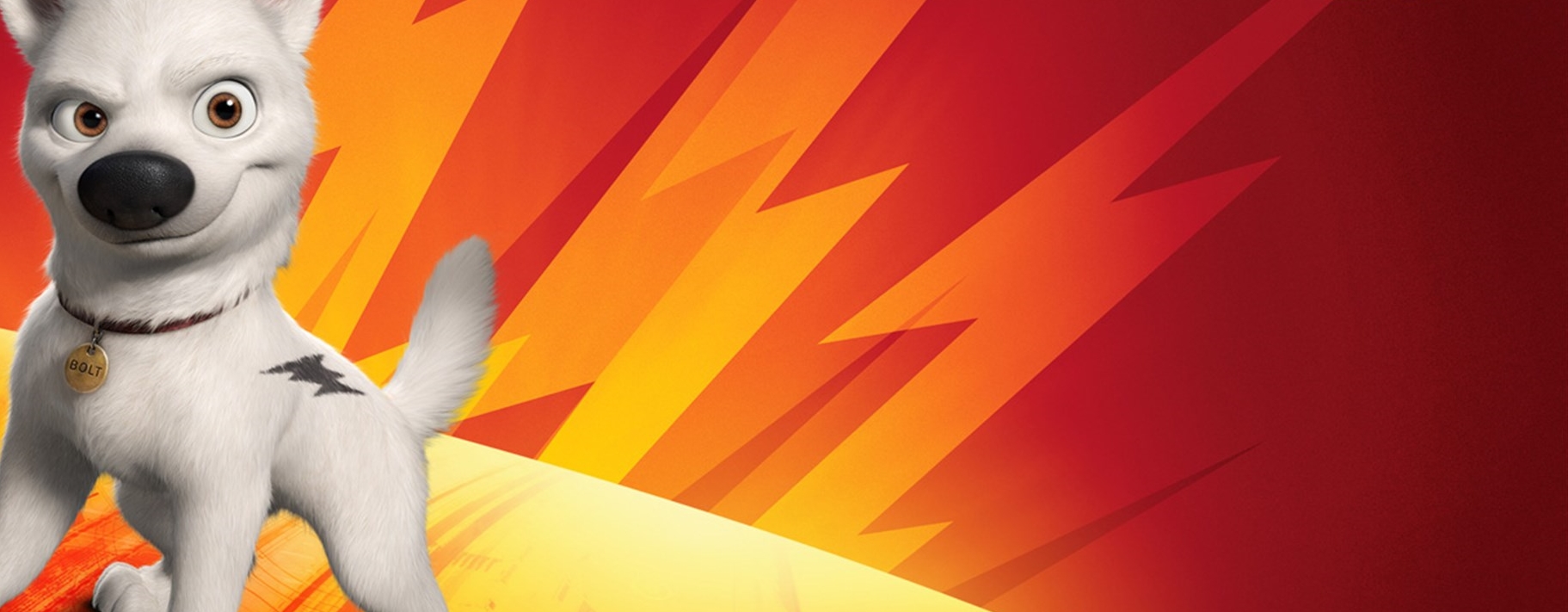
Disney’s 2008 feature, Bolt, follows the television star pup who believes that, through the meticulous production of the show, he has super-powers and faces an archvillain, the green-eyed man. When the plotline demands that he be separated from his owner and co-star, Penny, due to her being kidnapped on the show, Bolt escapes the set in an attempt to rescue her from this fictional peril. Accidentally shipped to the other side of the country, he begins his cross-country journey back to Penny with the help of the begrudging cat, Mittens, and hamster, Rhino, who of course happens to be a ‘Bolt’ super-fan.
The film sticks to the family-friendly adventure genre, cleverly tying the sci-fi sequences of the television show into the narrative along with heart-tugging moments of reflection. The film is credited with spear-heading the Disney Revival, leaving behind a number of mildly successful features, with critic Wright suggesting that, “Bolt is that one movie that helped Disney Animation to refine itself.” [1] The film’s good reception and launching of the Revival indicate its successful blending of action with classic Disney sentiment in the form of a moral message; animals don’t belong in the entertainment business. The film is also characteristic of a road movie in that, “the conflicts that consume their characters are basically internal ones” [2], as they do not come from their displacement, but from coming to terms with their exploitation or commodification.
Throughout, the film represents the dog as capable of great emotion in order to effectively convey the mistreatment of animals in the film industry. The computer-generated animation style and advancements in non-photorealistic rendering allow Williams and Howard to quickly establish the anthropomorphic quality of the animal characters. Particular focus on the titular white German Shepherd results in an incredibly human-like range and depth of emotion, both in the face and movements of the animal, consolidated by Angelini’s assertion that herself and the other animators were able to achieve, “a very sentimental and internalized performance”. [3]
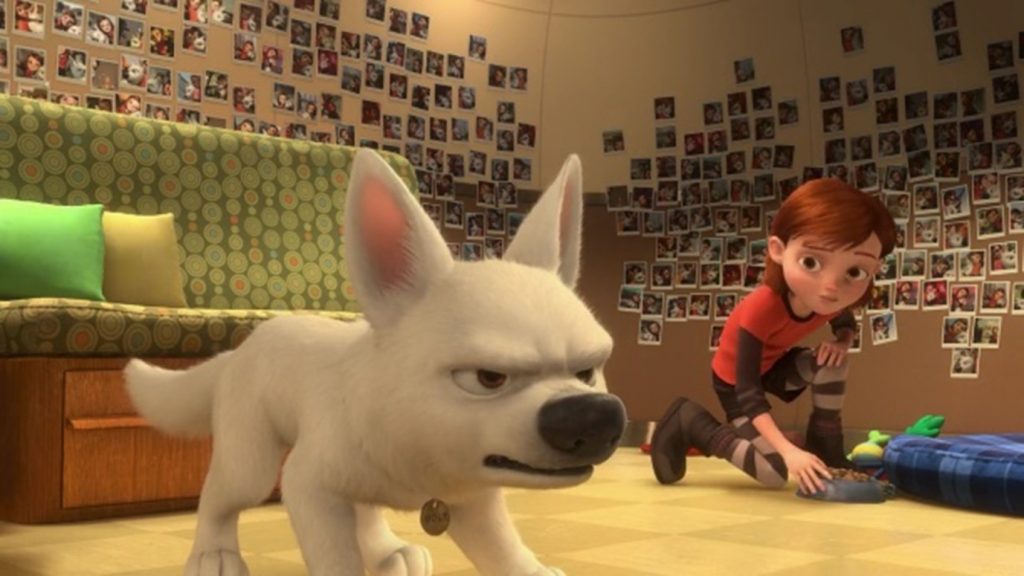
This achievement is evident in Bolt’s representation within his trailer home after a day of filming (figure 3), as his furrowed expression and poised stance reveal his being on-edge and indicate an inability to relax since he believes they are under threat. Even as Penny places his food on the floor, he refuses to let his guard down, something that any dog-owner would find surprising given their ‘cupboard love’ behaviour. By depicting Bolt in such an aggressive and upsetting manner, the film critiques the damaging psychological and behavioural consequences of using animals in television and film. The mise-en-scène compliments the commentary made through Bolt’s appearance as the background, composed by an extensive collection of polaroid images that are taken after shooting, detail the serious breadth of his confinement on set. These photos also draw attention to the walls and the limited space they permit, an unfair living situation for the star of the show, especially considering his breed and size which indicate that he needs lots of exercise, again critiquing the treatment of animals on set.
“I see an animal who believes with every fibre of his being, every fibre, that the girl he loves is in mortal danger – I see a depth of emotion on the face of that canine, the likes of which has never been captured on screen before”
– Director of the fictional ‘Bolt’ television show
This comment , made by the television show’s director, acknowledges and even highlights the genuine and profound response evoked in animal actors on set, though the film somewhat trivialises this issue to fit the family-friendly genre in that he goes on to emphasise the importance of tricking the dog into thinking this is his reality, suggesting that Bolt would behave differently if they did not hide the fact he was being recorded. In real-world contexts, animals lack the comprehension necessary to distinguish between life on and off set so regardless of whether Bolt noticed recording equipment or other clues as to its artificiality, he would experience the distressing events and interactions as though they were authentic. However, the film is able to imaginatively explore this distinction later in the narrative, as the audience is clued in to the fact that even when removed from the studio and its smoke and mirrors, Bolt genuinely believes he has superpowers and faces the threats that exist in the fictional television show, better reflecting an animals’ inability to separate reality from what occurs while the cameras are rolling. Child has described the animal protagonist as, “an echo of Jim Carrey’s Truman Burbank” [4], but unlike in The Truman Show, Bolt will never be able to achieve an understanding of the fraud committed against him. His lack of agency on set represents how animals are rendered props rather than actors. As such, the film succeeds in reflecting that Bolt does not really enjoy his role in the film industry, he just genuinely believes it to be his life, so unlike the representation of animals in other films where they can be seen to actively and enthusiastically partake in activities that put themselves at risk, such as bullfighting in Ferdinand or street performance in Vivo, the film avoids presenting a damaging view on the issue to the audience.
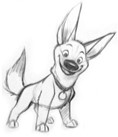
When Penny asks to bring Bolt home for the weekend and is met with the TV executive’s reply, “I have to remind you; this is Bolt’s world, he has to stay right here”, the film reflects humans’ sometimes egotistical and deluded perspective of the human-animal relationship whereby they believe that they are giving this animal a good life by giving it fame and material goods, when he is not afforded the simple pleasures that matter most to his species like exercising in big open spaces and spending quality time with an owner. At this point, Penny objects and verbalises the film’s moral issue, “But he never gets to be a real dog”. The fact that Penny is the only one able to object and show empathy, as the only non-adult whose current livelihood doesn’t depend on Bolt’s exploitation, showcases how the human-animal relationship is jeopardised by its monetisation.
The animation of Bolt’s ears in the previously discussed shot (figure 3) is also very significant in reflecting his intense emotion, particularly his anxiousness. The lead character designer, Joe Moshier has pointed out, “American White Shepherds have really long ears, a trait that I tried to caricature in order to allow the animators to emphasize Bolt’s expressiveness.” [5] This can be seen in early sketches of the character design for Bolt (figure 4).
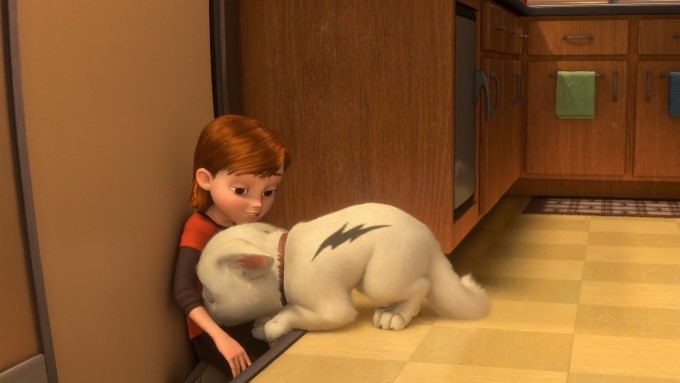
In figure 3, they appear tall, as expected when recalling an image of the breed, to show his alertness and compliment his aggressive expression but we see their effective utilisation when moments later, they are shown in extreme contrast. As Penny goes to leave the trailer, Bolt jumps in her way and buries his head in her shirt to show his overwhelming distress at being left alone (figure 5). In this position, his ears are tilted completely backwards out of stress and fearfulness [6], further criticising the use of animals on set as well as their treatment.
Later in the film, they are used once again to shape our interpretation of a very significant moment. Spectating from the top of a moving vehicle (figure 6), Bolt briefly catches a glimpse of a dog and their owner playing fetch on a hillside (figure 7). His expression is quite difficult to read, reflecting his happiness at even observing such an interaction but muddled with the unignorable sense that something is wrong. Looking at his ears, one noticeably more askew than the other, it is confirmed to the viewer that Bolt is uncharacteristically confused as to why he can’t be allowed to live like the other dog. The animation and character design here are crucial in representing Bolt’s struggling to come to terms with his exploitation and being held back from the ‘dog things’ that Mittens teaches him to do.

Figure 6: Bolt observes a dog and their owner play together 
Figure 7: Bolt’s view of dog and owner playing together
The camerawork presents the scene on the hillside (figure 7) as an eyeline match for the passing Bolt (figure 6), suggesting a meaningful connection between the two, a moment of realisation. The shot’s lighting reflects Bolt’s idyllic perspective on the life of the other dog and gives the impression that he has immediately romanticised this human-animal dynamic in his mind, as the two figures stand basked in sunlight. Their backlighting also alludes to the idea that they are symbolic of the ideal human-animal relationship and convey his longing for a life off set where he can have this fabled relationship. The upsetting implication that he will never fulfil this dream while involved in the television show ultimately condemns the use of animals in the industry.
The sad reality of the human-animal relationship is represented through the film’s depiction of the animal shelter, where an ‘ADOPT-A-PET WEEK’ banner hangs over a bleakly designed room (figure 8). The banner adds pathetically to the sombre setting and reflects their having to resort to an attempt to commercialise pet adoption by creating a week for it, hinting at the wider commodification of pets. The camera’s position behind the dogs facing the cage (figure 9) places the viewer inside with them, replicating the depressing experience of being locked up. Additionally, when Rhino enters the room in his hamster ball, they all go crazy, demonstrating their being starved of activity. By these means, the film represents the animals as being gravely mistreated. The large number of dogs in the shelter, presented visually and emphasised through loud intradiegetic sounds of barking, suggests that these animals are a replaceable commodity and critiques the human-animal relationship in which pets are bought and swiftly abandoned. This issue is also illuminated through Mittens’ referring to the animal shelter as, “a place where humans go animal-shopping”, appropriately articulating the commodification of pets in the human-animal relationship.

Figure 8: Interior of animal shelter 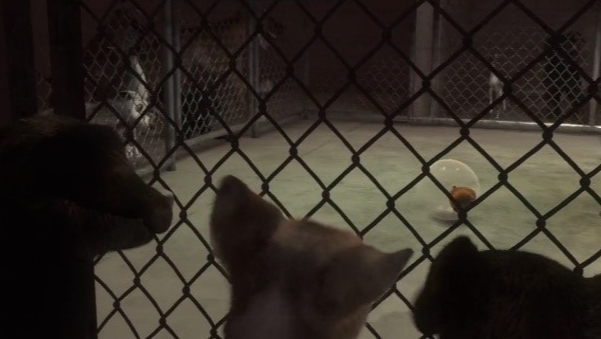
Figure 9: Animal shelter dogs in cages
The main perspective offered by the film is quite obviously that animals should not be used in the television and film industry, instilled through an incredibly emotive portrayal of the constant exploitation and mistreatment of the protagonist and other dogs. The other recurring message to take away from the feature is to be aware of the commodification of animals and pets, present in the production of Hollywood hits, but as close as the local animal shelter. Overall, it cannot be denied that the film does a good job in representing animals that are mistreated and encouraging healthy attitudes towards pet care. In fact, PETA listed Bolt as one of the good films for animals of 2008 along with Marley and Me [7], and it doesn’t get much better than their stamp of approval. Leventi-Perez highlights Disney’s lacking portrayal of animals’ right to be free of oppression, noting Bolt as one of only two exceptions in their 2000’s films [8], so perhaps the film’s evocative representation of animals is even responsible for its kickstarting the Disney Revival. Either way, Bolt’s timeless message makes it a heart-warming and worthy addition to the Disney catalogue.
[1] Gary Wright, ‘Disney Revival Rundown: Bolt’, Rotoscopers, 2015 <https://www.rotoscopers.com/2015/02/17/disney-revival-rundown-bolt/> [accessed 12 January 2022].
[2] Walter Salles, ‘Notes for a Theory of the Road Movie’, The New York Times Magazine, 2007 <https://www.nytimes.com/2007/11/11/magazine/11roadtrip-t.html> [accessed 15 January 2022].
[3] Jérémie Noyer, ‘Bolt: Cinzia Angelini – one bold, Bolt animator!’, Animated Views, 2008 <https://animatedviews.com/2008/bolt-cinzia-angelini-one-bold-bolt-animator/> [accessed 12 January 2022].
[4] Ben Child, ‘You review: Bolt’, The Guardian, 2009 <https://www.theguardian.com/film/filmblog/2009/feb/16/you-review-bolt> [accessed 12 January 2022].
[5] Dave Smith, ‘Ask Dave: The Ultimate Disney History Expert’, D23. Archived from the original on 1 June 2009.
[6] Pet Botanics, ‘Help Your Clients Understand What Their Dog Is “Saying”’, Pet Botanics, 2019 <https://www.petbotanics.com/blog/post/reading-canine-body-language> [accessed 15 January 2022].
[7] Amy Elizabeth, ‘Top (and Bottom) Films for Animals in 2008’, PETA, 2008 <https://www.peta.org/blog/top-bottom-films-animals-2008/> [accessed 12 January 2022].
[8] Oana Leventi-Perez, ‘Disney’s Portrayal of Nonhuman Animals in Animated Films Between 2000 and 2010’ (unpublished doctoral thesis, Georgia State University, 2011), p. 116, in Database of ScholarWorks: Georgia State University <https://scholarworks.gsu.edu/communication_theses/81> [accessed 12 January 2022].
Bibliography
Child, Ben, ‘You review: Bolt’, The Guardian, 2009 <https://www.theguardian.com/film/filmblog/2009/feb/16/you-review-bolt> [accessed 12 January 2022]
Elizabeth, Amy, ‘Top (and Bottom) Films for Animals in 2008’, PETA, 2008 <https://www.peta.org/blog/top-bottom-films-animals-2008/> [accessed 12 January 2022]
Leventi-Perez, Oana, ‘Disney’s Portrayal of Nonhuman Animals in Animated Films Between 2000 and 2010’ (unpublished doctoral thesis, Georgia State University, 2011), in Database of ScholarWorks: Georgia State University <https://scholarworks.gsu.edu/communication_theses/81> [accessed 12 January 2022]
Noyer, Jérémie, ‘Bolt: Cinzia Angelini – one bold, Bolt animator!’, Animated Views, 2008 <https://animatedviews.com/2008/bolt-cinzia-angelini-one-bold-bolt-animator/> [accessed 12 January 2022]
Pet Botanics, ‘Help Your Clients Understand What Their Dog Is “Saying”’, Pet Botanics, 2019 <https://www.petbotanics.com/blog/post/reading-canine-body-language> [accessed 15 January 2022]
Salles, Walter, ‘Notes for a Theory of the Road Movie’, The New York Times Magazine, 2007 <https://www.nytimes.com/2007/11/11/magazine/11roadtrip-t.html> [accessed 15 January 2022]
Smith, Dave, ‘Ask Dave: The Ultimate Disney History Expert’, D23. Archived from the original on 1 June 2009
Williams, Chris and Byron Howard, dir., Bolt (Walt Disney Studios Motion Pictures, 2008)
Wright, Gary, ‘Disney Revival Rundown: Bolt’, Rotoscopers, 2015 <https://www.rotoscopers.com/2015/02/17/disney-revival-rundown-bolt/> [accessed 12 January 2022]
Further Reading
Molloy, Claire, Popular Media and Animals (Basingstoke: Palgrave Macmillan, 2011)
PETA, ‘Animals in Movies and on Television: Cruelty Behind the Scenes’, PETA, [n.d.] <https://www.peta.org/issues/animals-in-entertainment/animals-in-film-tv/> [accessed 12 January 2022]
Wells, Paul, ‘You Can See What Species I Belong to – but Don’t Treat Me Lightly: Rhetorics of Representation in Animated Animal Narratives’, in Animal Life and the Moving Image, ed. by Michael Lawrence and Laura McMahon (London: Palgrave Macmillan, 2015), pp. 95-107
